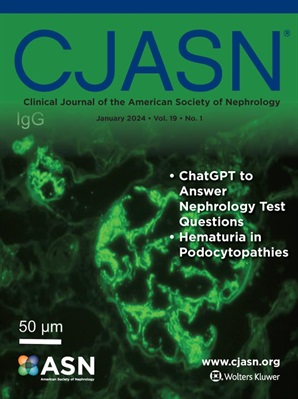钠-葡萄糖共转运蛋白-2抑制剂治疗和常染色体显性多囊肾病退伍军人肾功能的纵向变化
IF 8.5
1区 医学
Q1 UROLOGY & NEPHROLOGY
Clinical Journal of the American Society of Nephrology
Pub Date : 2025-05-16
DOI:10.2215/cjn.0000000725
引用次数: 0
摘要
背景:钠-葡萄糖共转运蛋白-2抑制剂(SGLT2i)是肾脏疾病治疗的支柱,但其在常染色体显性多囊肾病(ADPKD)中的疗效尚不清楚。我们评估了SGLT2i对ADPKD患者肾功能的影响。方法退伍军人健康管理局的这项回顾性队列研究纳入了2017年1月至2023年5月期间启动SGLT2i的患有ADPKD诊断代码的成年人。使用重复测量模型评估SGLT2i启动前后的eGFR斜率。在ADPKD和2型糖尿病(T2DM)患者中,我们采用目标试验模拟来比较SGLT2i与二肽基肽酶-4抑制(DPP4i)对eGFR斜率的影响。结果在348例开始SGLT2i的符合条件的ADPKD患者中,93%为男性,平均±标准差年龄为68±11,中位eGFR为53(四分位数范围:16-127)ml/min/1.73m2。在校正分析中,起始前eGFR斜率为-0.79(95%可信区间:-1.26,-0.33)ml/min/1.73m2 / 90天。在起始后的前3个月,eGFR斜率急剧上升至-2.78 (-4.04,-1.53)ml/min/1.73m2,然后在起始后的3 ~ 12个月稳定为-0.07 (-0.72,0.58)ml/min/1.73m2。目标试验仿真比较了217个sgltti用户和198个dpp4i用户。在调整后的分析中,在开始治疗后的前三个月,SGLT2i-患者的eGFR每90天下降-4.03 (-6.45,-1.60)mL/min/1.73m2;然而,在随后的3- 12个月内,SGLT2i-的坡度比dpp4i -更稳定,每90天差异为1.29 (0.16,2.41)mL/min/1.73m2。结论:在轻度ADPKD、糖尿病和心血管疾病高发的老年患者中,开始SGLT2i的eGFR在最初的三个月下降,随后在一年的随访中趋于稳定。与使用DPP4i相比,在合并T2DM的患者中,使用SGLT2i与开始治疗后3- 12个月间eGFR下降较慢相关。这些发现表明,SGLT2is对老年ADPKD患者有潜在的益处,在这些患者中,合并症可能在肾功能下降中发挥更大的作用,但还需要进一步的研究。本文章由计算机程序翻译,如有差异,请以英文原文为准。
Sodium-Glucose Cotransporter-2 Inhibitor Therapy and Longitudinal Changes in Kidney Function among Veterans with Autosomal Dominant Polycystic Kidney Disease.
BACKGROUND
Sodium-glucose cotransporter-2 inhibitors (SGLT2i) are a pillar of kidney disease therapy, but their efficacy remains unknown in Autosomal Dominant Polycystic Kidney Disease (ADPKD). We evaluated effects of SGLT2i on kidney function in ADPKD.
METHODS
This retrospective cohort study within the Veterans Health Administration included adults with an ADPKD diagnosis code who initiated SGLT2i between January 2017 and May 2023. Repeated measures models were used to evaluate eGFR slope before and after SGLT2i initiation. Among patients with ADPKD and type 2 diabetes mellitus (T2DM), a target trial emulation was used to compare the effects of SGLT2i versus dipeptidyl peptidase-4 inhibition (DPP4i) on eGFR slope.
RESULTS
Among 348 eligible patients with ADPKD who started an SGLT2i, 93% were male, mean ± standard deviation age was 68 ± 11, and median eGFR was 53 (interquartile range: 16-127) ml/min/1.73m2. In adjusted analyses, the pre-initiation eGFR slope was -0.79 (95% confidence interval: -1.26, -0.33) ml/min/1.73m2 per-90-days. The eGFR slope steepened to -2.78 (-4.04, -1.53) ml/min/1.73m2 during the first three months post-initiation, and then stabilized to -0.07 (-0.72, 0.58) ml/min/1.73m2 during months 3-to-12 post-initiation. The target trial emulation compared 217 SGLT2i-users with 198 DPP4i-users. In adjusted analyses, eGFR declined -4.03 (-6.45, -1.60) mL/min/1.73m2 per-90-days faster in SGLT2i- versus DPP4i-users during the first three months post-initiation; however, during the subsequent 3-to-12 months, the slope was more stable in SGLT2i- than DPP4i-initiators, with a difference of 1.29 (0.16, 2.41) mL/min/1.73m2 per-90-days.
CONCLUSIONS
In older patients with mild ADPKD and a high prevalence of diabetes and cardiovascular disease who initiated an SGLT2i, there was an initial three-month decline in eGFR followed by stabilization during the remainder of the year-long follow-up. Compared with DPP4i use, SGLT2i use was associated with a slower eGFR decline between 3-to-12 months post-initiation in patients with concurrent T2DM. These findings suggest that SGLT2is are potentially beneficial in older individuals with ADPKD in whom comorbid disease may play a greater role in kidney function decline, but further studies are required.
求助全文
通过发布文献求助,成功后即可免费获取论文全文。
去求助
来源期刊
CiteScore
12.20
自引率
3.10%
发文量
514
审稿时长
3-6 weeks
期刊介绍:
The Clinical Journal of the American Society of Nephrology strives to establish itself as the foremost authority in communicating and influencing advances in clinical nephrology by (1) swiftly and effectively disseminating pivotal developments in clinical and translational research in nephrology, encompassing innovations in research methods and care delivery; (2) providing context for these advances in relation to future research directions and patient care; and (3) becoming a key voice on issues with potential implications for the clinical practice of nephrology, particularly within the United States. Original manuscript topics cover a range of areas, including Acid/Base and Electrolyte Disorders, Acute Kidney Injury and ICU Nephrology, Chronic Kidney Disease, Clinical Nephrology, Cystic Kidney Disease, Diabetes and the Kidney, Genetics, Geriatric and Palliative Nephrology, Glomerular and Tubulointerstitial Diseases, Hypertension, Maintenance Dialysis, Mineral Metabolism, Nephrolithiasis, and Transplantation.

 求助内容:
求助内容: 应助结果提醒方式:
应助结果提醒方式:


